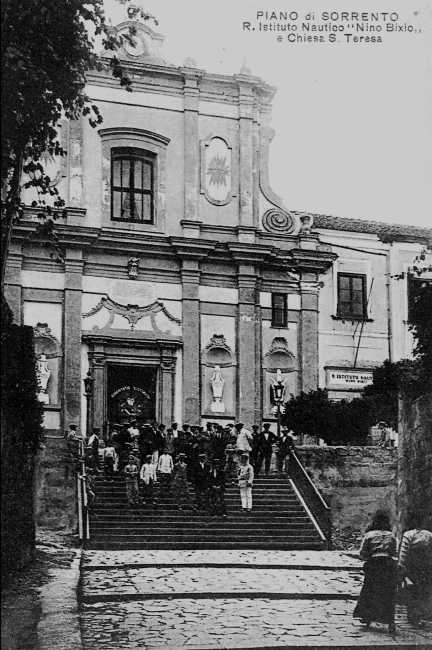Curiosità
La città ospita il museo archeologico territoriale George Vallet.
Gli arredi ritrovati nelle tombe di Trinità sono tutti raccolti nel Museo Archeologico Territoriale della Penisola Sorrentina, a Villa Fondi, in Piano di Sorrento. Qui sono confluite anche molte testimonianze delle altre popolazioni che hanno frequentato Piano e l’intera Penisola.
Mario Stefanile in uno dei suoi diari lo definì “il quadrivio più bello del mondo”.
L’Arciconfraternita Morte ed Orazione fu fondata a Piano pare nel 1629, aggregata a quella fondata a Roma nel 1538. Essa fu inizialmente eretta nella chiesa di S.Michele e proprio in quell’anno risalirebbero anche le tradizioni della Settimana Santa. Al giovedì santo, con saio nero la confraternità porta i simboli dello stendardo e del pannetto per le strade di Piano con i lampioni e le rappresentazioni della Passione di Cristo (misteri e Martiri) ed il meraviglioso ciro del Miserere. Le confratrerenite di Piano visitano gli altari della Reposizione la sera del Giovedì o alla notte portando in processione anche l’Addolorata. La processione del Cristo Morto si svolge invece al tramonto del venerdì santo L’Arciconfraternita mel 1758 riceve l’assenso regio di Carlo III di Borbone.  Il 19 settembre del 1970 viene inaugurato il Teatro delle Rose in via Delle Rose con quasi mille posti a sedere ed una moderna struttura recettiva, destinata ad ospitare grandi eventi teatrali e cinematografici e divenendo un fiore all’occhiello fra le attività recettive turistiche dell’intera penisola.
Il 19 settembre del 1970 viene inaugurato il Teatro delle Rose in via Delle Rose con quasi mille posti a sedere ed una moderna struttura recettiva, destinata ad ospitare grandi eventi teatrali e cinematografici e divenendo un fiore all’occhiello fra le attività recettive turistiche dell’intera penisola.
Nel 1348 il nobile di Sorrento Francesco Vulcano destina una somma di 350 ducati per l’istituzione di una scuola nautica al Piano di Sorrento. Nel 1636 l’Università del Piano stampa per la prima volta patenti mercantili per naviganti istruiti presso la propria scuola nautica dimostrando la preparazione dei propri marittimi nel campo nautico. La scuola si trasferì così a Marina di Cassano. Un’altra scuola nautica nacque nel territorio di Meta.
G. Valletta, nel 1783 dona una ingente quantità di danaro per la costruzione di un istituto nautico a Carotto in luogo delle antiche scuole nautiche L’anno seguente si crea una nuova scuola nautica a Carotto.
L'Istituto Nautico “N. Bixio”, uno dei più antichi d’Italia, è ubicato nell’antio convento di Santa Teresa, che ha conservato, pur tra interventi deprecabili, l’antico chiostro con il colonnato ad archi.
Il 24 giugno 1933 i Principi Maria Josè ed Umberto di Savoia fanno visita all’Isttuto Nautico per lo scoprimento di una lapide dedicata ai Caduti ex allievi della Scuola nella guerra mondiale.
Translation by Ida Iaccarino
The town hosts the Archaeological Territorial Museum “George Vallet”.
The archaeological finds found in the tombs at Trinità are all kept in theArchaeological Territorial Museum of the Sorrento Peninsula, at Villa Fondi, in Piano di Sorrento. The museum also preserves evidence of other people, who used to live in Piano di Sorrento and in the whole peninsula.
The Italian journalist and critic Mario Stefanile described Piano in one of his journals as “the most beautiful crossroads in the world”. Apparently, the Archconfraternity of “Death and Prayer” was founded in Piano di Sorrento in 1629, aggregated with the homonymous one founded in 1538 in Rome. Initially, it was founded in Saint Michael’s Church and the Holy Week ceremonies and traditions started in the same year. On Maundy Thursday the confraternity members usually wear a black habit and carry the symbols of the standard and the pall in a procession around the streets of Piano. The procession also carries lamps, some representations of the Passion of Christ (mysteries and martyrdom) and is accompanied by the wonderful choir of the “Miserere”. The confraternities of Piano visit the altars of Deposition in the evening on Maundy Thursday or during the night, while they carry in procession also the statue of “Our Lady of Sorrows”. The procession of Dead Christ takes place at dusk on Good Friday instead. The archconfraternity obtained the royal assent of Charles III of Bourbon in 1758.
The Delle Rose Theatre (situated in Delle Rose Street) was inaugurated on the 19th of September, 1970. It had almost one thousand seats and modern accommodation facilities, which were intended to host great theatrical and film events. For this reason it became the showpiece among the tourist accommodation facilities in the entire peninsula.

In 1348 Francesco Vulcano, a nobleman from Sorrento, allocated a sum of 350 ducats for the establishment of a nautical college in Piano di Sorrento. In 1636 the University (intended as community) of Piano printed, for the first time, boating licences for the seafarers instructed at its nautical college, in order to show the qualifications of its seamen in the nautical field. This is why the college moved to the sea village of Marina di Cassano. Another nautical college was established in the town of Meta di Sorrento.
G. Valletta donated a considerable sum of money in 1783 for the construction of a nautical college in Carotto (another name for Piano di Sorrento), in place of the ancient nautical school. The following year, a new nautical college was founded inCarotto.
The nautical college “N. Bixio” (one of the most ancient ones in Italy) is situated in the old convent of Saint Teresa, which has preserved, despite some deplorable interventions, the ancient cloister with the arched colonnade. visited the nautical college to unveil a memorial tablet dedicated to the fallen who where ex students of the college during World War I.




